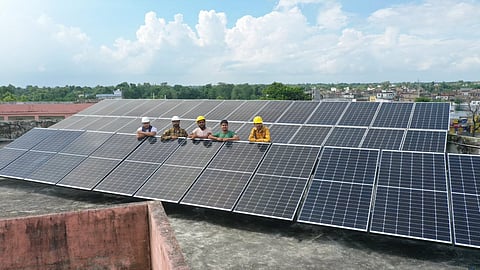
- News
- Women
- Magazine
- IndustryIndustry
- InsightsInsights
- Success Stories
- PublishPublish
- ContactContact
- Media KitMedia Kit

You're interested in solar energy but aren't sure what materials the equipment used to implement it is comprised of? We deconstruct the components of solar panels for you to better comprehend.Loom Solar provides you a low-cost, all-inclusive solar panel installation package that includes: administrative assistance, a link with a certified craftsman in your area... You'll be able to get started with confidence!
A solar panel is a sun-powered sensor. As a result, a "solar panel" can refer to both a heat-generating and an electricity-generating module. Solar energy is used to power the photovoltaic panel. The thermal panel, on the other hand, generates heat by using the calories provided by the sun.Concentrate on silicon, which is the primary component of solar panels. A photovoltaic solar panel, for example, is made composed of numerous different materials that allow it to convert sunlight into energy.When you look at a solar panel, it appears to be uniform, but it is really made up of a slew of little photovoltaic cells, which are comprised of a semi-conductive substance with an average electrical conductivity: most of the time, silicon. Sand or quartz is heated and exposed to carbon in a chemical reaction.
For the composition of a photovoltaic solar panel, silicon may be found in two distinct forms:·
Monocrystalline silicon is a huge homogenous cylinder of blue/black tint that is created from a single crystal. Solar panels made from this sort of silicon, therefore, are likewise of this hue. The Bi-facial solar panels are the best type of the Monocrystalline solar panels for home available in Indian Market.
Polycrystalline silicon has a more heterogeneous look because it is made up of several assembled crystals. The solar panels, which have a blue tinge yet are mosaic-like, demonstrate this.
Amorphous silicon is a non-crystallized form of silicon that is less common and efficient than the other two.
On a daily level, there are several benefits to switching to solar energy:
You save energy and money: your bills might be reduced by up to 40-50%! You're more self-sufficient and generate your own energy.
You participate in the energy transition and do not pollute the earth by using the sun, a natural and unlimited energy supply.
You know how much your house is worth on the real estate market and how much it might be sold or rented for.
Well, I'm sure you already know this, but when a solar panel generates power, it creates no CO2. Where it falls short is at the manufacturing level. The transition of silicon necessitates a lot of energy...
Do you understand the concept of embodied energy? It is the total of all energy required for the creation of a single substance. The solar panel, on the other hand, generates more energy during its lifetime than it took to create it.
In reality, a solar panel owner's energy debt is repaid within the first five years. This implies that it will only create carbon-free power after 5 years.
If you want to know the answers for more interesting questions or want a free quote then click here.
Follow us on Google News
